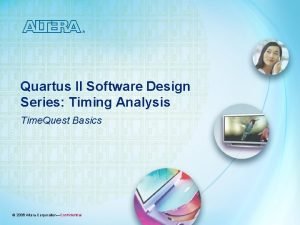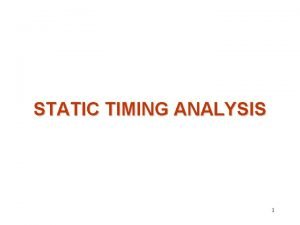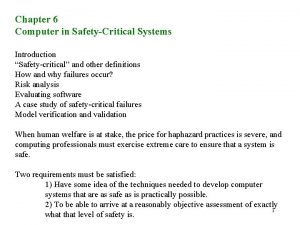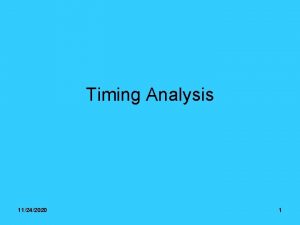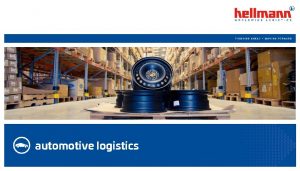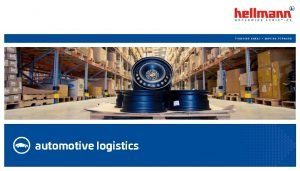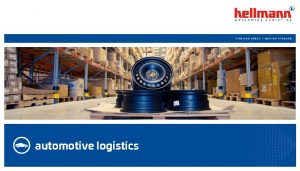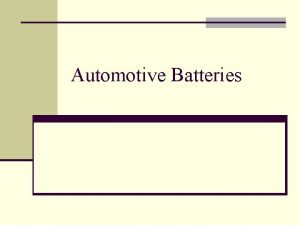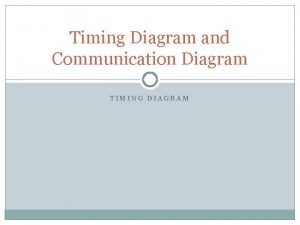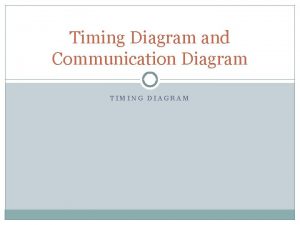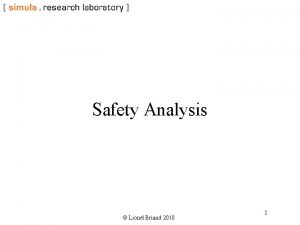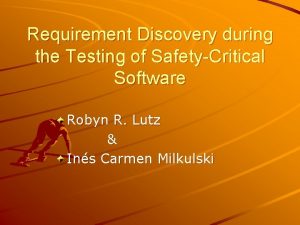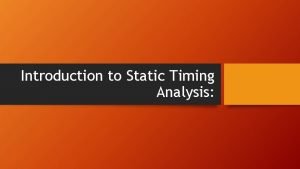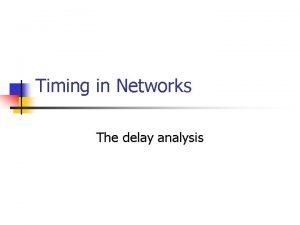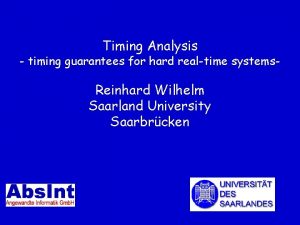Timing Analysis of SafetyCritical Automotive Software The AUTOSAFE











![Timing Analysis: Task Level (Auto. Gen [5]) • Based on explicit-state model checking • Timing Analysis: Task Level (Auto. Gen [5]) • Based on explicit-state model checking •](https://slidetodoc.com/presentation_image_h/37ec50f22ab77797c0058dda51ff94d1/image-12.jpg)
![Timing Analysis: System Level (chron. VAL [6]) • Real-Time Calculus (RTC) [2] • Architectural Timing Analysis: System Level (chron. VAL [6]) • Real-Time Calculus (RTC) [2] • Architectural](https://slidetodoc.com/presentation_image_h/37ec50f22ab77797c0058dda51ff94d1/image-13.jpg)









- Slides: 22

Timing Analysis of Safety-Critical Automotive Software: The AUTOSAFE Tool Flow M. Becker 1, S. Mohamed 2, K. Albers 3, P. P. Chakrabarti 2, S. Chakraborty 1, P. Dasgupta 2, S. Dey 2, R. 2 Indian Institute of Technology 1 Technische Universität München, Real-Time Computer Systems (RCS) (IIT) Kharagpur, Computer Science and Engineering (CSE) 4 Tata Research 3 INCHRON Gmb. H 12 -03 -2021 Development and Design Centre (TRDDC) Formal Verification Research Group, IIT Kharagpur 1

Outline q Introduction q Motivation and Goals q AUTOSAFE flow ■ ■ A. From High-Level Specification to Task Mapping B. Timing Analysis C. Automata Generation and Formal Verification D. Closing the loop q Example q Conclusion 12 -03 -2021 Formal Verification Research Group, IIT Kharagpur 2

Introduction q Currently: automotive architectures getting complex: ■ Hardware: 50 -100 ECUs, numerous sensors and actuators, kilometers of cabling, . . . ■ Software: ≈100 M lines of code, many safety-critical functions ■ More functionality, more interfaces, much more software ■ Testing becomes infeasible! ■ How to guarantee that the software is „correct“? 12 -03 -2021 Formal Verification Research Group, IIT Kharagpur 3

Motivation and Goals q Co-design of real-time control – typical design flow ■ Requires analysis and optimisation skills from multiple disciplines ● Control design ● Real-time analysis ● Formal verification ■ Tool flows in each realm lacks interface points between each other q Goal: To create an interface between multiple disciplines 12 -03 -2021 Formal Verification Research Group, IIT Kharagpur 4

Motivation and Goals q Control design Typical Design Flow ■ Numerous Assumptions High-level Model ● Negligible delays ● Computation – Instantaneous, Periodic Control Performance satisfied Code Generation q Formal Verification Execution Time satisfied Low-level Platform Model q Several design iterations needed ■ Design without any analytic backup ■ Hinders Certification Response Time satisfied Implementation Performance not met 12 -03 -2021 q Real-time analysis q A semantic gap exists between highlevel models and their implementation q Goal: To bridge this semantic gap Formal Verification Research Group, IIT Kharagpur 5

AUTOSAFE Flow - Overview High-level Model Performance criteria not satisfied Control Performance satisfied High-level Model Code Generation Execution Time satisfied Low-level Platform Model 12 -03 -2021 Performance criteria satisfied Implementation Timing Information Response Time satisfied Formal Verification Research Group, IIT Kharagpur 6

AUTOSAFE Flow 12 -03 -2021 Formal Verification Research Group, IIT Kharagpur 7

A. From High-Level Specification to Task Mapping i. High-level specification i. Functional behaviour of the system ii. Timing constraints ii. Functional modeling of the system • Tools like MATLAB Simulink iii. Control theoretic analysis i. Generate formal properties (control performance specification) iv. Generate C code v. Modeling system architecture vi. Mapping • Binding of functional parts to the architecture blocks 12 -03 -2021 Formal Verification Research Group, IIT Kharagpur 8

From High-Level Specification to Task Mapping q Example: ABS ■ Performance specification ● Car shall stop within a certain distance when the brakes are applied ■ Functional specification ● Regulate brake pressure to keep slip at an optimal value (20%) ■ Timing constraint ● Threshold for fresh or stale sensor data ■ Control theoretic analysis Fig: Anti-lock braking system with distributed sensors and ● Quantify freshness in terms of (m, k)-firm deadline [1] Hamdaoui, Moncef, and Parameswaran Ramanathan. "A dynamic priority assignment technique for streams with ( § m Transactions out of k successive runs meet Computers, IEEE on 44. 12 (1995): 1443 -1451. deadline 12 -03 -2021 Formal Verification Research Group, IIT Kharagpur 9

B. Timing Analysis q. Goal: predict safe upper bound for end-to-end timing of implementation (incl. scheduling, bus arbitration, etc. ) A) task-level timing analysis worst-case execution time per task B) system-level timing analysis compose tasks via shared resources 12 -03 -2021 Formal Verification Research Group, IIT Kharagpur 10

Timing Analysis: Task Level q Scheduling diagrams for each ecu Sensor 1 task t Sensor 2 task ECU 1 t ECU 2 Bus t Controller ECU 12 -03 -2021 Formal Verification Research Group, IIT Kharagpur 11
![Timing Analysis Task Level Auto Gen 5 Based on explicitstate model checking Timing Analysis: Task Level (Auto. Gen [5]) • Based on explicit-state model checking •](https://slidetodoc.com/presentation_image_h/37ec50f22ab77797c0058dda51ff94d1/image-12.jpg)
Timing Analysis: Task Level (Auto. Gen [5]) • Based on explicit-state model checking • Idea: work at source level, allows better abstractions • Problem: differences in control flow between source and binary • „backtranslate“ differences & timing • Slicing and abstraction • Ask MC for timing 7. Timer <= X 8 paths? abstract source w/ timing Model checker no Yes WCET <= X 3. Extract timing 6. Slicing & abstraction w. r. t. timing 3. Extract Control flow source w/ timing 4. compare binary 2. Cross. Compile flow 5. 1. Extract difference Translate source Control flow s Binary flow to WCET estimate source [5] Bokil, Prasad, et al. "Automatic test data generation for c programs. " Third 12 -03 -2021 IEEE International Conference on. Formal Verification Research Group, IIT Kharagpur Secure Software Integration and Reliability Improvement, SSIRI 2009. 12
![Timing Analysis System Level chron VAL 6 RealTime Calculus RTC 2 Architectural Timing Analysis: System Level (chron. VAL [6]) • Real-Time Calculus (RTC) [2] • Architectural](https://slidetodoc.com/presentation_image_h/37ec50f22ab77797c0058dda51ff94d1/image-13.jpg)
Timing Analysis: System Level (chron. VAL [6]) • Real-Time Calculus (RTC) [2] • Architectural nodes: buses, ECUs, etc. • Each node manipulates a stream of incoming tasks • Nodes have capacities according to their policy • Needs WCET service ( l, u) curve ( l, u) ( l’, u’) RTC arrival curve ( l’, u’) bounds for end-to -end delays [2] Samarjit Chakraborty, et al. "A General Framework for Analysing System Properties in Platform-Based Embedded System Designs. " DATE. Vol. 3. 2003. [6] Anssi, Saoussen, et al. "chron. VAL/chron. SIM: A Tool Suite for Timing Verification of Automotive Applications. " Proc. 12 -03 -2021 Formal Verification Research Group, IIT Kharagpur 13

q Abs on architetcure : : RTCs generated αl={(0, 0), (10, 1), (20, 2), . . } αu={(0, 1), (10, 2), (20, 3), . . } Sensor 1 task Sensor 2 αl = {(0, 0), (20, 1), (40, 2), . . } task αu = {(0, 1), (20, 2), (40, 3), . . } ECU 1 ECU 2 Bus αl={(15. 34, 1), (25. 34, 2), (35. 34, 3), . . } αu={(0, 1), (4. 66, 2), (14. 66, 3), . . } αl = {(26. 29, 1, 0), (30. 29, 2, 0), (46. 29, 3, 0), …} αu = {(0, 1), (1. 11, 2), (11. 11, 3), . . } Controller ECU 12 -03 -2021 Formal Verification Research Group, IIT Kharagpur WCRT = 5. 4 BCRT = 1. 11 14

Example: ABS 12 -03 -2021 Formal Verification Research Group, IIT Kharagpur 15

C. Automata Generation and Formal Verification q High-level timed automata model of the system ■ Event or task generating automata ● Uses system level timing analysis results – RTC curves ■ Task automaton ● Uses task level timing analysis results – WCET ● Tracks task generation, execution and completion ■ Scheduler automaton ● To specify tasks’ scheduling policy ■ Resource automaton ● Models and simulates system architecture ■ Observer automaton ● Quantifies the parameters for verification q Formal verification using UPPAAL [3] Behrmann, Glenn, et al. "UPPAAL 4. 0. " IEEE Third 12 -03 -2021 International Conference on Quantitative Evaluation of System Formal Verification Research Group, IIT Kharagpur 16

C. Automata Generation and Formal Verification q ABS properties q RTC TA q For time threshold = 4 s, the maximum (m, k)-firm tolerance for sensor 1 data = fresh and sensor 2 data = stale is (4, 5) q Timed event Generation satisfying RTC is easier q For time threshold = 6 s, the (m, k)firm tolerance for both sensor data = fresh, does not go below (8, 10) q Formal verification tools available 12 -03 -2021 q Abstractions of the system can be easily represented Formal Verification Research Group, IIT Kharagpur 17

Example: ABS Query: If m is reachable? 12 -03 -2021 Formal Verification Research Group, IIT Kharagpur 18

D. Closing the loop q Properties are satisfied ■ Formal guarantee provided by the tool flow q Property violations ■ Counterexample trace ● If spurious? § Modify respective RTC curves ■ Re-execute tool flow like CEGAR loop [4] Clarke, Edmund, et al. "Abstraction and counterexample-guided refinement in model checking of hybrid systems. " International Journal of Foundations of Computer Science 14. 04 (2003): 583 -604. 12 -03 -2021 Formal Verification Research Group, IIT Kharagpur 19

Conclusion q AUTOSAFE flow – an integrated approach to system design ■ An interface between different realms ● Control designer species the control law ● Embedded systems engineer comes up with implementation mapping ● Verification engineer checks for target property q Co-design of real-time control made easier q Automating model refinement using CEGAR loop is part of future work 12 -03 -2021 Formal Verification Research Group, IIT Kharagpur 20

References 1. Hamdaoui, Moncef, and Parameswaran Ramanathan. "A dynamic priority assignment technique for streams with (m, k)-firm deadlines. " Computers, IEEE Transactions on 44. 12 (1995): 14431451. 2. Samarjit Chakraborty, Simon Künzli, and Lothar Thiele. "A General Framework for Analysing System Properties in Platform-Based Embedded System Designs. " DATE. Vol. 3. 2003. 3. Behrmann, Glenn, et al. "UPPAAL 4. 0. " IEEE Third International Conference on Quantitative Evaluation of Systems, QEST 2006. 4. Clarke, Edmund, et al. "Abstraction and counterexample-guided refinement in model checking of hybrid systems. " International Journal of Foundations of Computer Science 14. 04 (2003): 583604. 5. Bokil, Prasad, et al. "Automatic test data generation for c programs. " Third IEEE International Conference on Secure Software Integration and Reliability Improvement, SSIRI 2009. 6. Anssi, Saoussen, et al. "chron. VAL/chron. SIM: A Tool Suite for Timing Verification of Automotive 12 -03 -2021 21 Applications. " Proc. Embedded Real-Time Software and Systems, ERTS (2012). Formal Verification Research Group, IIT Kharagpur

THANK YOU !!! Sajid Mohamed sajidm@atdc. iitkgp. ernet. in 12 -03 -2021 Formal Verification Research Group, IIT Kharagpur 22
 Quartus timing analysis
Quartus timing analysis Tom spyrou
Tom spyrou Hình ảnh bộ gõ cơ thể búng tay
Hình ảnh bộ gõ cơ thể búng tay Slidetodoc
Slidetodoc Bổ thể
Bổ thể Tỉ lệ cơ thể trẻ em
Tỉ lệ cơ thể trẻ em Chó sói
Chó sói Tư thế worm breton
Tư thế worm breton Chúa sống lại
Chúa sống lại Môn thể thao bắt đầu bằng chữ f
Môn thể thao bắt đầu bằng chữ f Thế nào là hệ số cao nhất
Thế nào là hệ số cao nhất Các châu lục và đại dương trên thế giới
Các châu lục và đại dương trên thế giới Công của trọng lực
Công của trọng lực Trời xanh đây là của chúng ta thể thơ
Trời xanh đây là của chúng ta thể thơ Mật thư anh em như thể tay chân
Mật thư anh em như thể tay chân Làm thế nào để 102-1=99
Làm thế nào để 102-1=99 độ dài liên kết
độ dài liên kết Các châu lục và đại dương trên thế giới
Các châu lục và đại dương trên thế giới Thể thơ truyền thống
Thể thơ truyền thống Quá trình desamine hóa có thể tạo ra
Quá trình desamine hóa có thể tạo ra Một số thể thơ truyền thống
Một số thể thơ truyền thống Cái miệng nó xinh thế chỉ nói điều hay thôi
Cái miệng nó xinh thế chỉ nói điều hay thôi Vẽ hình chiếu vuông góc của vật thể sau
Vẽ hình chiếu vuông góc của vật thể sau
